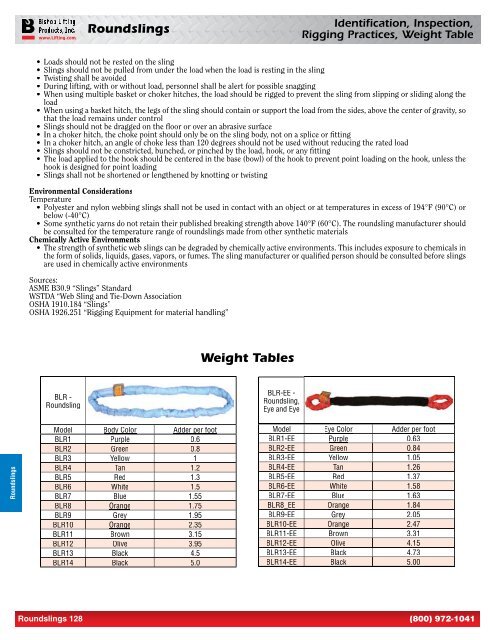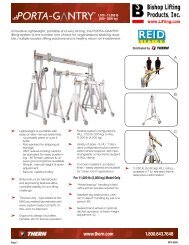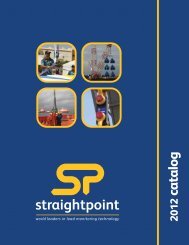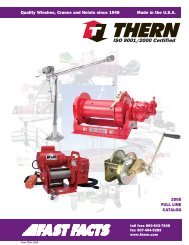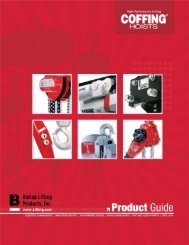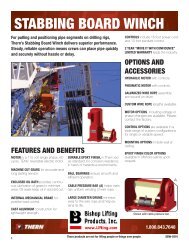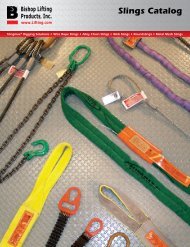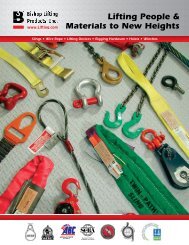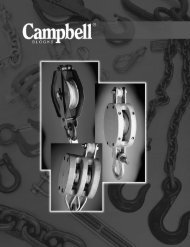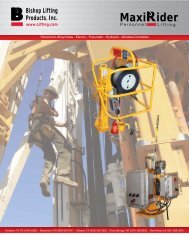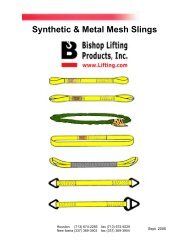warning - Bishop Lifting Products, Inc.
warning - Bishop Lifting Products, Inc.
warning - Bishop Lifting Products, Inc.
Create successful ePaper yourself
Turn your PDF publications into a flip-book with our unique Google optimized e-Paper software.
Roundslings<br />
Identification, Inspection,<br />
Rigging Practices, Weight Table<br />
• Loads should not be rested on the sling<br />
• Slings should not be pulled from under the load when the load is resting in the sling<br />
• Twisting shall be avoided<br />
• During lifting, with or without load, personnel shall be alert for possible snagging<br />
• When using multiple basket or choker hitches, the load should be rigged to prevent the sling from slipping or sliding along the<br />
load<br />
• When using a basket hitch, the legs of the sling should contain or support the load from the sides, above the center of gravity, so<br />
that the load remains under control<br />
• Slings should not be dragged on the floor or over an abrasive surface<br />
• In a choker hitch, the choke point should only be on the sling body, not on a splice or fitting<br />
• In a choker hitch, an angle of choke less than 120 degrees should not be used without reducing the rated load<br />
• Slings should not be constricted, bunched, or pinched by the load, hook, or any fitting<br />
• The load applied to the hook should be centered in the base (bowl) of the hook to prevent point loading on the hook, unless the<br />
hook is designed for point loading<br />
• Slings shall not be shortened or lengthened by knotting or twisting<br />
Environmental Considerations<br />
Temperature<br />
• Polyester and nylon webbing slings shall not be used in contact with an object or at temperatures in excess of 194°F (90°C) or<br />
below (-40°C)<br />
• Some synthetic yarns do not retain their published breaking strength above 140°F (60°C). The roundsling manufacturer should<br />
be consulted for the temperature range of roundslings made from other synthetic materials<br />
Chemically Active Environments<br />
• The strength of synthetic web slings can be degraded by chemically active environments. This includes exposure to chemicals in<br />
the form of solids, liquids, gases, vapors, or fumes. The sling manufacturer or qualified person should be consulted before slings<br />
are used in chemically active environments<br />
Sources:<br />
ASME B30.9 “Slings” Standard<br />
WSTDA “Web Sling and Tie-Down Association<br />
OSHA 1910.184 “Slings”<br />
OSHA 1926.251 “Rigging Equipment for material handling”<br />
Weight Tables<br />
BLR -<br />
Roundsling<br />
BLR-EE -<br />
Roundsling,<br />
Eye and Eye<br />
Roundslings<br />
Model<br />
Body Color<br />
Adder per foot<br />
BLR1<br />
Purple 0.6<br />
BLR2 Green 0.8<br />
BLR3 Yellow 1<br />
BLR4 Tan 1.2<br />
BLR5 Red 1.3<br />
BLR6 White 1.5<br />
BLR7 Blue 1.55<br />
BLR8<br />
Orange 1.75<br />
BLR9<br />
Grey 1.95<br />
BLR10<br />
Orange 2.35<br />
BLR11 Brown 3.15<br />
BLR12 Olive 3.95<br />
BLR13 Black 4.5<br />
BLR14 Black 5.0<br />
Model<br />
Eye Color<br />
Adder per foot<br />
BLR1-EE<br />
Purple 0.63<br />
BLR2-EE Green 0.84<br />
BLR3-EE Yellow 1.05<br />
BLR4-EE Tan 1.26<br />
BLR5-EE Red 1.37<br />
BLR6-EE White 1.58<br />
BLR7-EE Blue 1.63<br />
BLR8_EE<br />
Orange 1.84<br />
BLR9-EE<br />
Grey 2.05<br />
BLR10-EE<br />
Orange 2.47<br />
BLR11-EE Brown 3.31<br />
BLR12-EE Olive 4.15<br />
BLR13-EE Black 4.73<br />
BLR14-EE Black 5.00<br />
Roundslings 128<br />
(800) 972-1041


